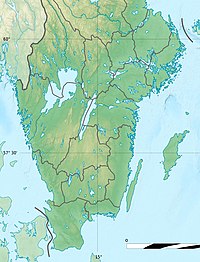HVDC Gotland
The HVDC Gotland was a high voltage direct current (HVDC) transmission between Västervik in Sweden and Ygne on Gotland . The first HVDC Gotland went into operation in 1954 and, with an operating voltage of 100 kV , was able to transmit an output of 20 MW through a 98 km long submarine cable . It was the first commercial installation for high-voltage direct current transmission in the western world and used mercury vapor rectifiers as power converters .
Endpoints of the HVDC Gotland through the Baltic Sea |
In 1970 the transmission capacity was increased to 30 MW and the transmission voltage to 150 kV by connecting a thyristor- fitted converter in series with the existing converter with mercury vapor rectifier . This was the first ever use of thyristors in a system for high-voltage direct current transmission.
However, the transmission capacity of this system was not sufficient either and so a completely new connection, the HVDC Gotland 2, was built in 1983 . It can transmit a maximum of 130 MW at a transmission voltage of 150 kV and is fully equipped with thyristors. It uses a 92.9 km long submarine cable and, unlike the first HVDC system, it also uses a 6.6 km long overhead line section that leads from the Västervik converter station to the Swedish coast. Wooden masts are used as masts.
In 1987 this system was replaced by another HVDC connection, Gotland 3 . It consists of a 98 km long underground and submarine cable route without overhead line sections and has a maximum transmission capacity of 130 MW at an operating voltage of 150 kV. This system made the first system installed in 1954 and expanded in 1970 superfluous and so it was shut down and dismantled after it was commissioned.
A piece of the first submarine cable can be viewed in the Deutsches Museum in Munich . It was built in Liljeholmen's cable factory in 1952 .
Web links
- The Gotland HVDC link - FIG
- Basics and history of HVDC technology (article Energie & Management 6/2005, p. 4)

